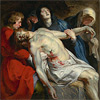
Each of the following lessons was written by a secondary-level teacher from the Los Angeles area. Developed through the Getty education department's professional-development program, the Secondary Teachers' Institute, these lessons were designed to be interdisciplinary and meet California Content Standards for visual arts and English–language arts, history–social sciences, or other disciplines.
For more information about the program, please e-mail teacherprograms@getty.edu.
|
 |
|
 |
 |
Lessons 1-7 of 7 |
 |
 |
 |
 |
 |

  |
 |
Impressionism: Prepositions and Monet
Grades/Level: Middle School (6–8)
Subjects: Visual Arts, English—Language Arts
Lesson Overview: Students will examine two paintings by Claude Monet, Still Life with Flowers and Fruit and Sunrise. They will apply their understanding of prepositions by writing poetry using prepositional phrases inspired by both paintings.
|
 |
 |
 |
Impressionism: What Can Art Tell Us about Ourselves?
Grades/Level: High School (9–12)
Subjects: Visual Arts, English—Language Arts, History—Social Science
Lesson Overview: Students will consider the challenges of life as an adolescent working in Paris in the late 1800s by analyzing a series of works of art. They will compare the vocations depicted in the artworks with those they might encounter in 21st-century Los Angeles.
|
 |
 |
 |
Revolutionary Europe: Science & Exploration in the Decorative Arts
Grades/Level: Middle School (6–8)
Subjects: Visual Arts, History—Social Science
Lesson Overview: Students will view three works of decorative arts and complete the accompanying activities to better understand the Age of Exploration and the Scientific Revolution, and how these "revolutions" and their discoveries influenced the new European world view.
|
 |
 |
 |
Revolutionary Europe: Rembrandt and Rubens Painting the Revolution
Grades/Level: High School (9–12)
Subjects: Visual Arts, History—Social Science
Lesson Overview: Students will learn about the Protestant Reformation and the Catholic Counter Reformation as related events. They will analyze works by the artists Rubens and Rembrandt, and use the artworks to illustrate the divergent beliefs and philosophies of the two movements.
|
 |
 |
 |
Documentary Photography: Body Image
Grades/Level: Middle School (6–8)
Subjects: Visual Arts
Lesson Overview: Students will analyze a photograph to learn about body image. They will also discuss how society views the human body in different cultures.
|
 |
 |
 |
Documentary Photography: Civil Rights Through Image and Text
Grades/Level: High School (9–12)
Subjects: Visual Arts, English—Language Arts, History—Social Science
Lesson Overview: Students will learn about the juxtaposition of image and text to define the social and psychological mood of the civil rights movement in the United States.
|
 |
 |
 |
Documentary Photography: Photography and Choreography
Grades/Level: High School (9–12)
Subjects: Visual Arts
Lesson Overview: Students will engage in visual and written activities that will support their creative process of choreographing a solo dance composition. The lesson includes motifs and the movement components—body, effort, shape, and space (BESS elements from Laban Movement Analysis).
|
 |
 |
 |
 |
 |
 |
Lessons 1-7 of 7 |
 |
 |
 |
 |
 |

  |
 |






